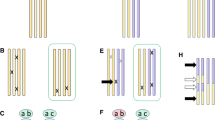Abstract
Heterosis research over the past century has focused primarily on diploid plants and animals. This is despite the fact that most heterotic organisms contain polyploid events in their recent and/or ancient past and various important crop species are heterotic polyploids. We present an argument for the study of heterosis within polyploid systems and give examples of how their study can improve current hypotheses and generate new ones. Polyploid systems allow experiments not possible in diploids but the insights gained must be incorporated into models to explain heterosis at all levels.

Similar content being viewed by others
References
Alexander DE, Sonnemaker EH (1961) Inbreeding depression in autotetraploid maize. Maize Genet Cooper Newsl 35:45
Bennett JH (1976) Expectations for inbreeding depression on self-fertilization of tetraploids. Biometrics 32(2):449–452. doi:10.2307/2529514
Bingham ET, Groose RW, Woodfield DR, Kidwell KK (1994) Complementary gene interactions in alfalfa are greater in autotetraploids than diploids. Crop Sci 34(4):823–829
Birchler JA (2013) Genetic rules of heterosis in plants. In: polyploid and hybrid genomics. Wiley, pp 313-321. doi:10.1002/9781118552872.ch19
Birchler JA, Yao H, Chudalayandi S, Vaiman D, Veitia RA (2010) Heterosis. Plant Cell 22(7):2105–2112. doi:10.1105/tpc.110.076133
Bruce AB (1910) The mendelian theory of heredity and the augmentation of vigor. Science 32(827):627–628. doi:10.2307/1635723
Busbice T, Wilsie CP (1966) Inbreeding depression and heterosis in autotetraploids with application to Medicago sativa L. Euphytica 15(1):52–67. doi:10.1007/BF00024079
Chang PL, Dilkes BP, McMahon M, Comai L, Nuzhdin SV (2010) Homoeolog-specific retention and use in allotetraploid Arabidopsis suecica depends on parent of origin and network partners. Genome Biol 11(12):R125. doi:10.1186/gb-2010-11-12-r125
Collares-Pereira MJ, Matos I, Morgado-Santos M, Coelho MM (2013) Natural pathways towards polyploidy in animals: the Squalius alburnoides fish complex as a model system to study genome size and genome reorganization in polyploids. Cytogenet Genome Res 140(2–4):97–116
Darwin CR (1876) The effects of cross and self fertilisation in the vegetable kingdom. John Murray, London
Dewey DR (1966) Inbreeding depression in diploid, tetraploid and hexaploid crested wheatgrass. Crop Sci 6:144–147
Dewey DR (1969) Inbreeding depression in diploid and induced-autotetraploid crested wheatgrass. Crop Sci 9(5):592–595
Duvick DN (2001) Biotechnology in the 1930s: the development of hybrid maize. Nat Rev Genet 2(1):69–74
East EM (1936) Heterosis. Genetics 21(4):375–397
Fisher RA (1949) The theory of inbreeding, 2nd edn. Academic Press, New York
Flagel LE, Wendel JF (2010) Evolutionary rate variation, genomic dominance and duplicate gene expression evolution during allotetraploid cotton speciation. New Phytol 186(1):184–193. doi:10.1111/j.1469-8137.2009.03107.x
Freeling M, Woodhouse MR, Subramaniam S, Turco G, Lisch D, Schnable JC (2012) Fractionation mutagenesis and similar consequences of mechanisms removing dispensable or less-expressed DNA in plants. Curr Opin Plant Biol 15(2):131–139. doi:10.1016/j.pbi.2012.01.015
Groose RW, Talbert LE, Kojis WP, Bingham ET (1989) Progressive heterosis in autotetraploid alfalfa: studies using two types of inbreds. Crop Sci 29(5):1173–1177. doi:10.2135/cropsci1989.0011183X002900050015x
Hollister JD, Gaut BS (2009) Epigenetic silencing of transposable elements: a trade-off between reduced transposition and deleterious effects on neighboring gene expression. Genome Res 19(8):1419–1428. doi:10.1101/gr.091678.109
Hollister JD, Smith LM, Guo Y-L, Ott F, Weigel D, Gaut BS (2011) Transposable elements and small RNAs contribute to gene expression divergence between arabidopsis thaliana and arabidopsis lyrata. Proc Natl Acad Sci 108(6):2322–2327. doi:10.1073/pnas.1018222108
Jones DF (1917) Dominance of linked factors as a means of accounting for heterosis. Genetics 2:466–479
Kato A, Birchler JA (2006) Induction of tetraploid derivatives of maize inbred lines by nitrous oxide gas treatment. J Heredity 97:39–44
Keeble F, Pellew C (1910) The mode of inheritance of stature and of time of flowering in peas (Pisum sativum). J Genet 1:47–56
Lippman ZB, Zamir D (2007) Heterosis: revisiting the magic. Trends Genet 23(2):60–66. doi:10.1016/j.tig.2006.12.006
Mayfield-Jones D, Washburn JD, Arias T, Edger PP, Pires JC, Conant GC (2013) Watching the grin fade: tracing the effects of polyploidy on different evolutionary time scales. Semin Cell Dev Biol 24:320–331. doi:10.1016/j.semcdb.2013.02.002
Miller M, Zhang C, Chen ZJ (2012) Ploidy and hybridity effects on growth vigor and gene expression in Arabidopsis thaliana hybrids and their parents. G3: Genes|Genomes|Genetics 2 (4):505–513. doi:10.1534/g3.112.002162
Mok DWS, Peloquin SJ (1975) Breeding value of 2n pollen (diplandroids) in tetraploid x diploid crosses in potatoes. Theor Appl Genet 46(6):307–314. doi:10.1007/BF00281153
Ohno S (1970) Evolution by gene duplication. Springer, New York
Riddle NC, Birchler JA (2008) Comparative analysis of inbred and hybrid maize at the diploid and tetraploid levels. Theor Appl Genet 116:563–576
Riddle NC, Kato A, Birchler JA (2006) Genetic variation for the response to ploidy change in Zea mays L. Theor Appl Genet 114:101–111
Riddle NC, Jinag H, An L, Doerge RW, Birchler JA (2010) Gene expression analysis at the intersection of ploidy and hybridity in maize. Theor Appl Genet 120:341–353
Schnable JC, Springer NM, Freeling M (2011) Differentiation of the maize subgenomes by genome dominance and both ancient and ongoing gene loss. Proc Natl Acad Sci USA 108(10):4069–4074. doi:10.1073/pnas.1101368108
Shull GH (1911) The genotypes of maize. Am Nat 45(532):234–252. doi:10.2307/2455739
Shull GH (1948) What is “Heterosis”? Genetics 33(5):439–446
Soltis DE, Albert VA, Leebens-Mack J, Bell CD, Paterson AH, Zheng C, Sankoff D, dePamphilis CW, Wall PK, Soltis PS (2009) Polyploidy and angiosperm diversification. Am J Bot 96(1):336–348. doi:10.3732/ajb.0800079
Yao H, Kato A, Mooney B, Birchler JA (2011) Phenotypic and gene expression analysis of a ploidy series of maize inbred Oh43. Plant Mol Biol 75:237–251
Yao H, Dogra Gray A, Auger DL, Birchler JA (2013) Genomic dosage effects on heterosis in triploid maize. Proc Natl Acad Sci USA 110(7):2665–2669. doi:10.1073/pnas.1221966110
Acknowledgments
Research supported by National Science Foundation grant DBI 0733857.
Author information
Authors and Affiliations
Corresponding author
Additional information
Communicated by Frederic Berger.
Rights and permissions
About this article
Cite this article
Washburn, J.D., Birchler, J.A. Polyploids as a “model system” for the study of heterosis. Plant Reprod 27, 1–5 (2014). https://doi.org/10.1007/s00497-013-0237-4
Received:
Accepted:
Published:
Issue Date:
DOI: https://doi.org/10.1007/s00497-013-0237-4




